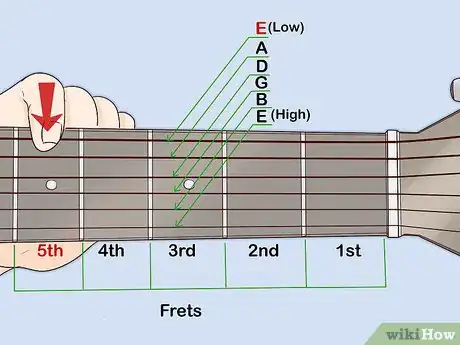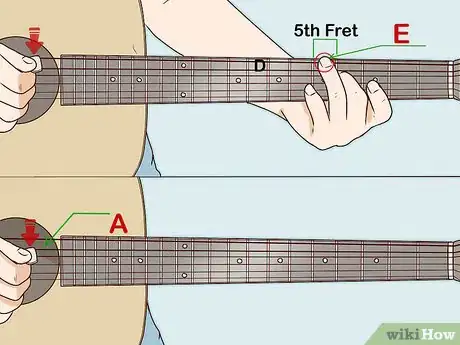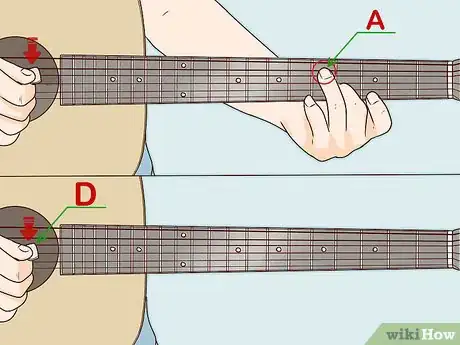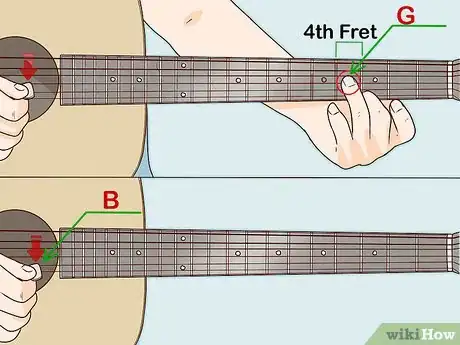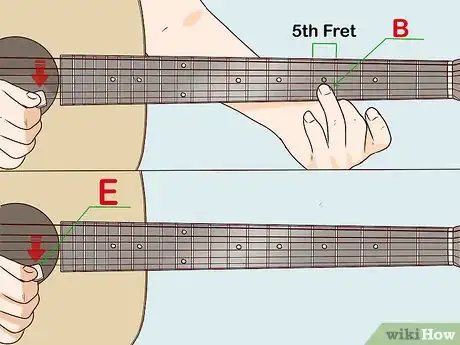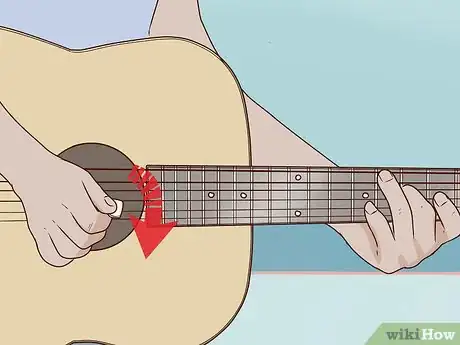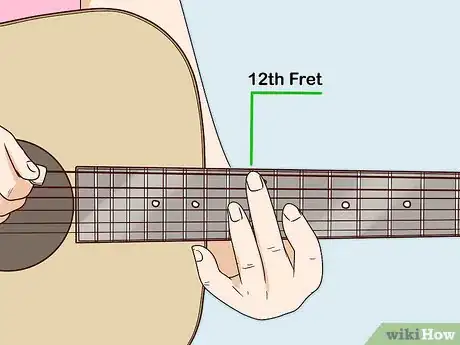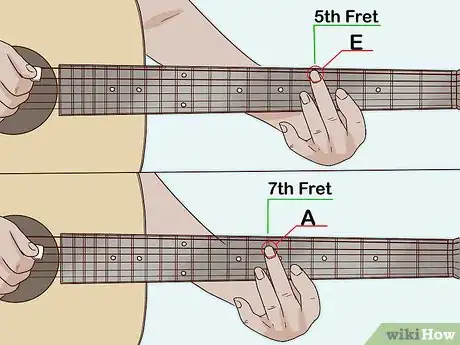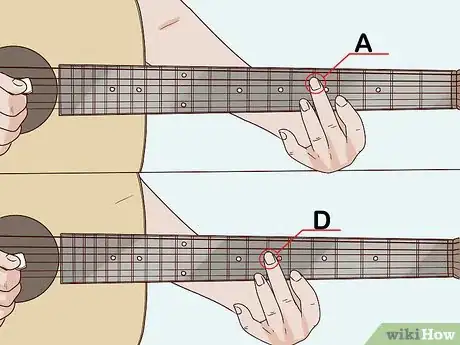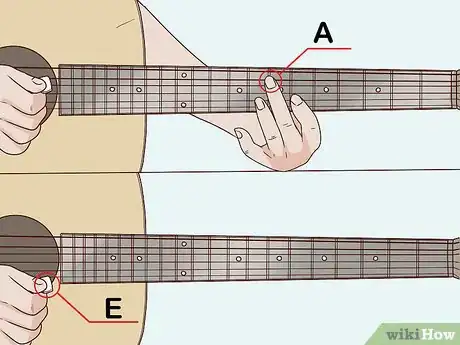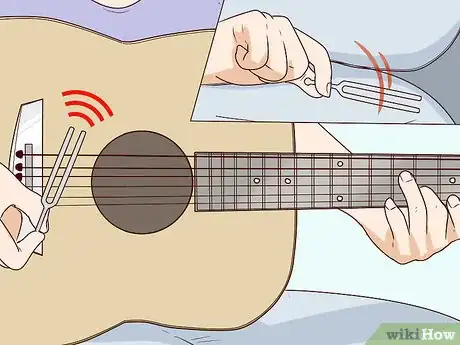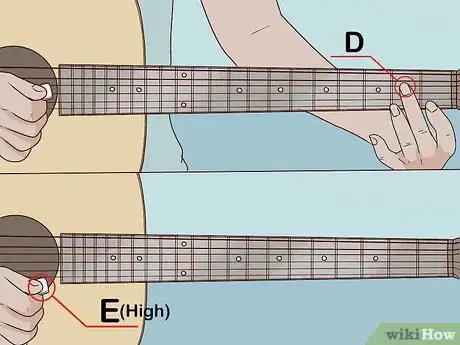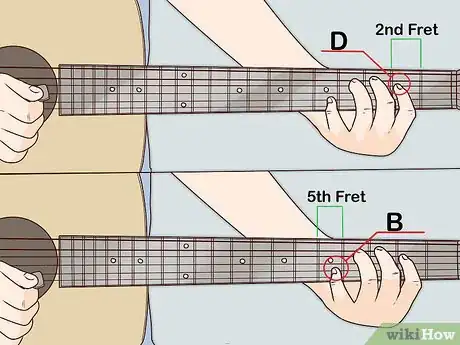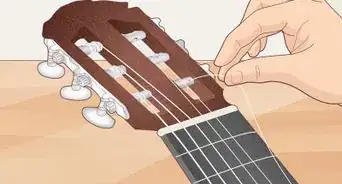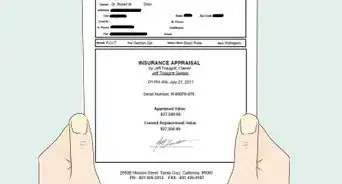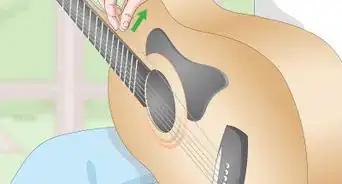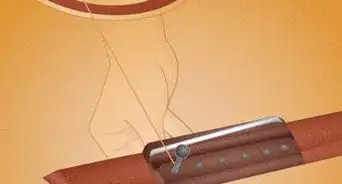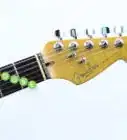This article was co-authored by Michael Papenburg and by wikiHow staff writer, Jennifer Mueller, JD. Michael Papenburg is a Professional Guitarist based in the San Francisco Bay Area with over 35 years of teaching and performing experience. He specializes in rock, alternative, slide guitar, blues, funk, country, and folk. Michael has played with Bay Area local artists including Matadore, The Jerry Hannan Band, Matt Nathanson, Brittany Shane, and Orange. Michael currently plays lead guitar for Petty Theft, a tribute to Tom Petty and the Heartbreakers.
This article has been viewed 257,994 times.
Before you play your guitar, you need to check to make sure it's in tune. A tuner makes this process relatively simple and straightforward. However, you may be in a situation where you don't have access to a tuner. You can tune your guitar without a tuner, either by tuning it to itself or using harmonics. Neither of these methods will necessarily tune your guitar to absolute pitch. If you're playing with other musicians, tune your guitar to absolute pitch using a reference note.[1]
Steps
Tuning Your Guitar to Itself
-
1Fret the low E string at the fifth fret. The low E string, also called the sixth string, is the lowest and thickest string on your guitar. If you're holding your guitar in playing position and looking down, it will be the top string closest to you.[2]
- The note at the fifth fret of the low E is the same as the open A string, the next string over from the low E.
- For this method, it isn't necessary to first tune your low E string. Even though your instrument may not be to concert pitch or absolute pitch, the strings will be tuned to each other. Anything you play will "sound right," as long as you're playing by yourself and not with another instrument tuned to concert pitch.
-
2Match the open A string to the low E string at the fifth fret. Listen to the sound coming from the low E string, then play the open A string. Tune the open A string up or down until it matches the sound coming from the low E string.[3]
- If the open A string is higher than the A you play at the fifth fret of the low E string, tune it down and then bring it back up.
Advertisement -
3Repeat the same process to tune the D and G strings. Once you have the A in tune, fret it at the fifth fret and pluck it. This is a D. Pluck the open D string, and tune the it up or down to match.[4]
- When the D string is in tune, fret it at the fifth fret to play a G. Pluck the open G string and compare. Tune it up or down to match the sound.
-
4Fret the G string at the fourth fret to tune the B string. The process changes somewhat for the B string, because there is a shorter interval between G and B. Fret the G string at the fourth fret to play a B. Pluck the open B string and compare the sounds.[5]
- Tune the open B string up or down until it matches the sound produced on the G string.
-
5Return to the fifth fret to tune the high E string. Once you have the B string in tune, fret it at the fifth fret and pluck to play a high E. Tune the open high E string up or down to match the sound coming from the B string.[6]
- If the open high E string is higher in pitch than the high E played on the B string, tune it down and then bring it up to pitch slowly and gradually. The high E string has a lot of tension and will snap easily.
-
6Strum a few chords to test your tuning. If you're getting ready to play a particular song, you may want to check your tuning with chords from that song to make sure it will sound okay. Listen carefully and adjust up or down as needed.[7]
- You can also use a tune-checking chord, made up of E's and B's, to tell if your guitar is in tune with itself. To play this chord, bar the fourth and fifth strings with your index finger at the second fret. Fret the third string at the fourth fret and the second string at the fifth fret. Play both the first and sixth strings open. If your guitar is in tune, you will only hear 2 notes.
Using Harmonics
-
1Touch the string lightly to play harmonics. Natural harmonics can be played at the twelfth, seventh, and fifth frets. Touch the string just above the fret, without applying any pressure. Strike the note with your picking hand, releasing the string at the fret at almost the same time you pluck it.[8]
- If you've never experimented with harmonics before, it may take a little practice before you can play them consistently. When you hear a bell-like sound, you know you've done it right.
- Harmonics is a relatively quiet method of tuning. You may not be able to use it if you're in a place with a lot of background noise.
-
2Play the harmonics at the twelfth fret to check your guitar's intonation. If your guitar's intonation is off, the harmonics won't match the pitch of the same note when you actually fret the note and play it. Choose a string and play the harmonic at the twelfth fret, then fret the twelfth note to play the actual note. Compare the sounds.[9]
- Repeat this with each string, since it's possible that intonation could be perfect on some strings but off on others.
- If your intonation is off, try changing your strings and see if that fixes the problem. If it doesn't, you may want to take your guitar into a shop and have a tech look at it.
-
3Compare harmonics to tune the A string to the low E string. Play the harmonic on the fifth fret of the low E string, then play the harmonic on the seventh fret of the A string. Listen carefully. You may have to play them several times.[10]
- Tune the A string up or down until the harmonic exactly matches the pitch of the harmonic played on the low E string.
- If you haven't tuned your low E string to a reference note, your guitar will be tuned to itself but not necessarily tuned to concert pitch or absolute pitch.
-
4Repeat the same process with the D and G strings. Once your A string is in tune, play the harmonic on the fifth fret of the A string and compare it to the harmonic on the seventh fret of the D string. Tune the D string up or down as necessary to match the pitch.[11]
- To tune the G string, play the harmonic on the fifth fret of the D string and compare it to the harmonic on the seventh fret of the G string.
-
5Play the harmonic on the seventh fret of the low E string to tune the B string. The harmonic on the seventh fret of the low E string produces the same pitch as the open B string when you strum it. You don't need to play harmonics on the B string, just strum the open string.[12]
- Tune the B string up or down until it matches the pitch perfectly.
-
6Tune the high E string using the harmonic on the seventh fret of the A string. The process for tuning the high E string is similar to the process you used for the B string. The open high E string should match the pitch produced when you play the harmonic on the seventh fret of the A string.[13]
- When you've tuned your high E string, your guitar should be in tune. Play a few chords to make sure everything sounds right.
Working from a Reference Note
-
1Use a tuning fork or other reference to tune your D string. If you want to get your guitar closer to concert pitch but don't have a tuner, you can use a reference note to get one string in tune, then tune the other strings to that string. A piano or keyboard can also give you a reference note.[14]
- If you find a reference note for the D string, you can tune both your low E and high E strings quickly using octaves.
- You can use other strings as a reference. However, if you use the D string your guitar will be more in tune across the whole range of the instrument.
-
2Fret the D string at the second fret and compare to the low E string. The note at the second fret of the D string is an E, but it is an octave higher than the pitch produced by the open low E string. Tune the open low E string up or down until they are playing the same pitch an octave apart. When the string is in tune, the sounds of the two strings will fit together, producing one rich sound.[15]
- Even though the notes are an octave apart, you should still be able to hear when they are in tune. If you have a hard time hearing it, use another tuning method until your ear is more developed.
-
3Compare the same note to the high E string. The E on the second fret of the D string is one octave lower than the open high E string. Carefully tune the high E string up or down until the two strings are in tune, an octave apart. The strings will sound together as one, without any wobbling.[16]
- If the high E string on your guitar is higher than it should be, tune it down first. Remember that you're tuning it one octave higher than your reference note – the E on the second fret of the D string. Be careful not to tune it too high, or it will snap.
-
4Match the same note to the fifth fret on the B string. The E at the fifth fret on the B string is the same note as the open high E. Play the E on the second fret of the D string. While fretting the B string at the fifth fret, tune the string up or down until it is playing the same note one octave higher.[17]
- While you can also tune the B to the open high E string, your guitar will be better tuned if you tune as many strings as possible to one string.
-
5Tune the A and G strings using relative tuning. From this point, the easiest way to tune the A string is to fret the low E string at the fifth fret and match the pitch of the open A string to that note. Then use the note at the fifth fret of the D string to tune the G string.[18]
- By following this method, you have tuned 5 of your 6 strings to the D string. Play a few chords to make sure your guitar sounds right, making adjustments where necessary.
Expert Q&A
Did you know you can get expert answers for this article?
Unlock expert answers by supporting wikiHow
-
QuestionWhat if my reference note is E instead of D?
 Michael PapenburgMichael Papenburg is a Professional Guitarist based in the San Francisco Bay Area with over 35 years of teaching and performing experience. He specializes in rock, alternative, slide guitar, blues, funk, country, and folk. Michael has played with Bay Area local artists including Matadore, The Jerry Hannan Band, Matt Nathanson, Brittany Shane, and Orange. Michael currently plays lead guitar for Petty Theft, a tribute to Tom Petty and the Heartbreakers.
Michael PapenburgMichael Papenburg is a Professional Guitarist based in the San Francisco Bay Area with over 35 years of teaching and performing experience. He specializes in rock, alternative, slide guitar, blues, funk, country, and folk. Michael has played with Bay Area local artists including Matadore, The Jerry Hannan Band, Matt Nathanson, Brittany Shane, and Orange. Michael currently plays lead guitar for Petty Theft, a tribute to Tom Petty and the Heartbreakers.
Professional Guitarist One of the easiest ways to tune your guitar manually is to find a reference note for E. Match that pitch to your lowest string, then play that string with your finger on the fifth fret. Compare that to the pitch of the open 5th string, which is the A string. When those notes are identical in pitch, fret the 5th string at the 5th fret and match it to the open 4th string. Keep doing this down each string. The only string that's slightly different is the second string, which you'd match by fretting the 3rd string at the 4th fret.
One of the easiest ways to tune your guitar manually is to find a reference note for E. Match that pitch to your lowest string, then play that string with your finger on the fifth fret. Compare that to the pitch of the open 5th string, which is the A string. When those notes are identical in pitch, fret the 5th string at the 5th fret and match it to the open 4th string. Keep doing this down each string. The only string that's slightly different is the second string, which you'd match by fretting the 3rd string at the 4th fret. -
QuestionAre the guitar strings EADGBE or EBDGAE?
 Community AnswerIt's standard to refer to the string order from lowest (thickest) to highest, from right to left. So EADGBE is correct.
Community AnswerIt's standard to refer to the string order from lowest (thickest) to highest, from right to left. So EADGBE is correct. -
QuestionWould a guitar be the same as piano in this pitch?
 Community AnswerYes. An E on the piano should be an E on a guitar, or it's not an E anymore. You have to make sure it's the right octave, however.
Community AnswerYes. An E on the piano should be an E on a guitar, or it's not an E anymore. You have to make sure it's the right octave, however.
References
- ↑ https://takelessons.com/blog/how-to-tune-a-guitar
- ↑ http://www.fretjam.com/how-to-tune-a-guitar.html
- ↑ http://www.fretjam.com/how-to-tune-a-guitar.html
- ↑ http://www.fretjam.com/how-to-tune-a-guitar.html
- ↑ http://www.fretjam.com/how-to-tune-a-guitar.html
- ↑ http://www.fretjam.com/how-to-tune-a-guitar.html
- ↑ https://classicalguitarshed.com/tune-guitar-by-ear/
- ↑ https://www.guitartricks.com/blog/10-Things-to-Know-About-Playing-Natural-Harmonics
- ↑ https://classicalguitarshed.com/tune-guitar-by-ear/
- ↑ https://classicalguitarshed.com/tune-guitar-by-ear/
- ↑ https://classicalguitarshed.com/tune-guitar-by-ear/
- ↑ https://classicalguitarshed.com/tune-guitar-by-ear/
- ↑ https://classicalguitarshed.com/tune-guitar-by-ear/
- ↑ https://classicalguitarshed.com/tune-guitar-by-ear/
- ↑ https://classicalguitarshed.com/tune-guitar-by-ear/
- ↑ https://classicalguitarshed.com/tune-guitar-by-ear/
- ↑ https://classicalguitarshed.com/tune-guitar-by-ear/
- ↑ https://classicalguitarshed.com/tune-guitar-by-ear/
- ↑ https://www.schoolofrock.com/resources/guitar/beginners-guide-to-tuning-a-guitar
- ↑ http://www.fretjam.com/how-to-tune-a-guitar.html
About This Article
To tune a guitar without a tuner, start by fretting the low E string at the fifth fret, which is the lowest and thickest string on your guitar. Next, play the A string and tune it up or down until it matches the sound from the E string. Then, match the D and G strings to the E string. For the B string, tune it up or down until it makes the same sound as the G string at the fourth fret. Finally, return to the fifth fret and match the high E string to the sound of the B string. To learn more, like how to tune your guitar using harmonics or a reference note, scroll down!
